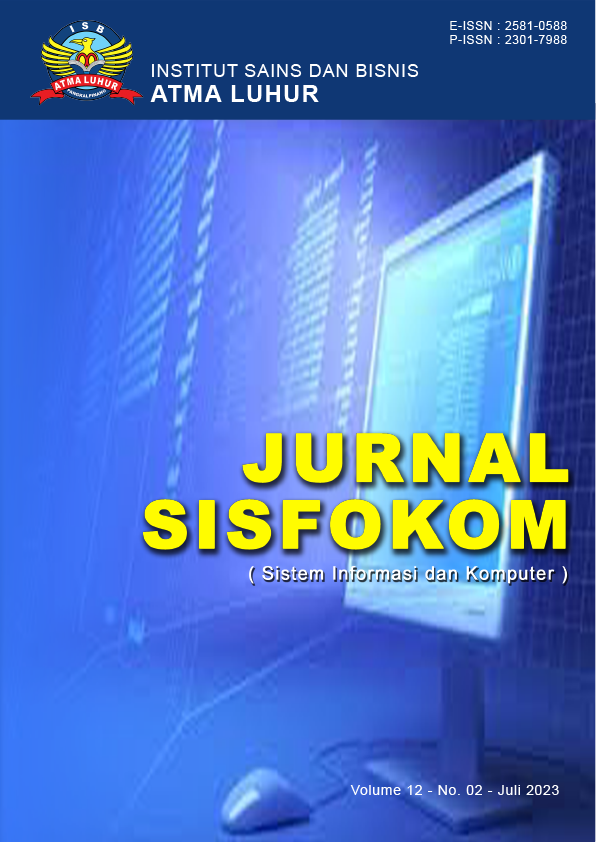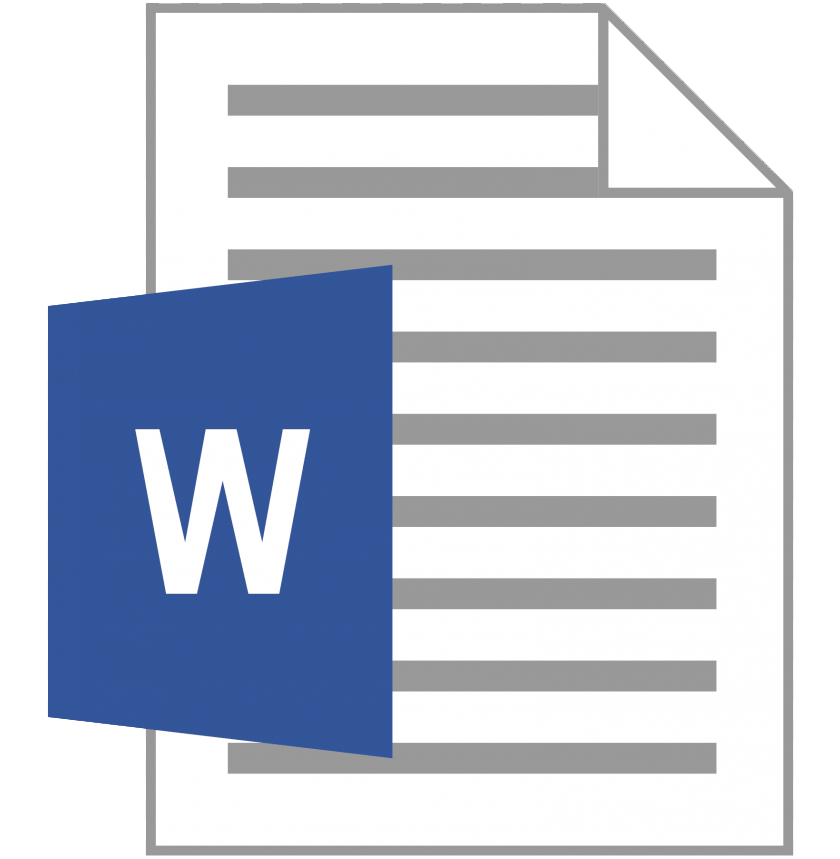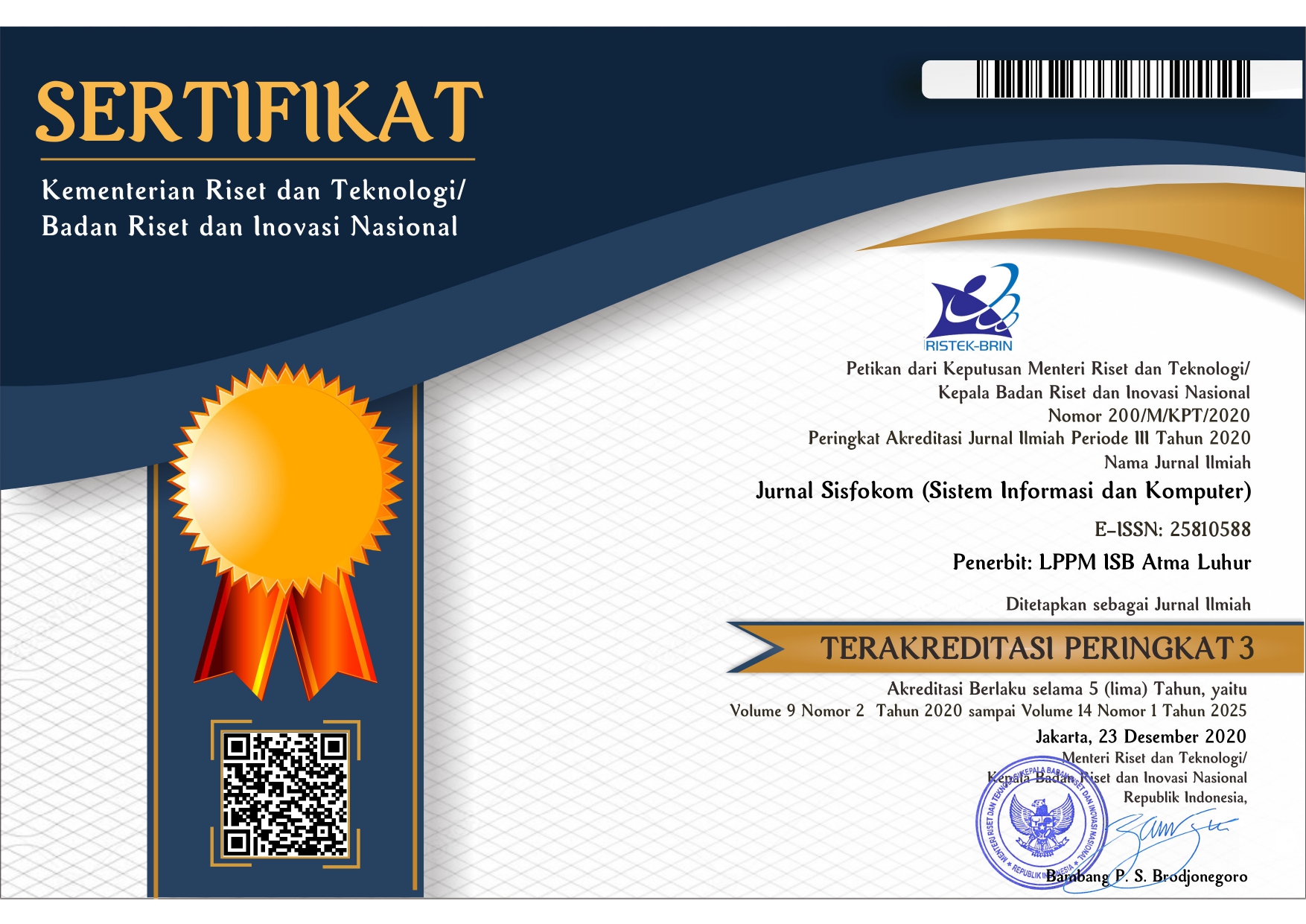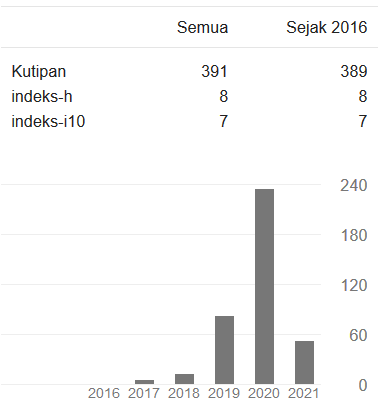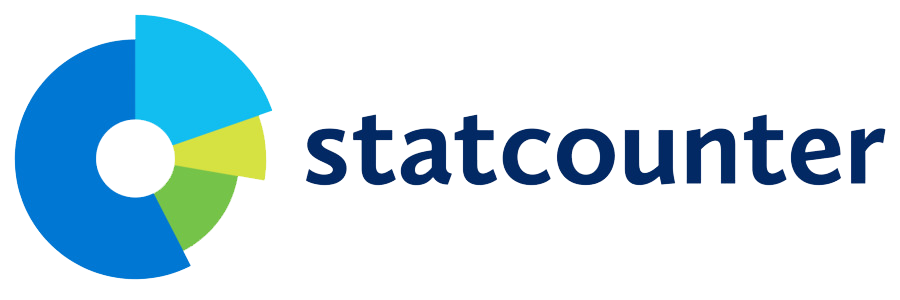The Impact of 5G Network Technology Transformation to Replace 4G Using the Sem Amos Method
DOI:
https://doi.org/10.32736/sisfokom.v12i2.1634Keywords:
Telecommunications, 4G, 5G Technologies, SEMAbstract
The development of the telecommunication world has occurred very rapidly and has been brought from the first generation, namely 1G to 4G, which has developed as a future network medium in several countries, successfully implemented in transactions. This research discusses the potential of 5G technology as a substitute for the previous technology, namely 4G. How can this technology be applied in Indonesia; which areas are suitable for implementing 5G technology? Data analysis for this study has been adapted to the research model and the variables studied. The causality model is used in this study, and the AMOS program's SEM (Structural Equation Modeling) analysis method is used to assess the research assumptions. The existence of the 5G network has brought Indonesia to the threshold of development that opens the door to a world full of opportunities, 5G technology is expected to have a positive impact on the development of digital skills and entrepreneurship, which will have a better impact.References
M. Danuri, “Development and transformation of digital technology,” Infokam, vol. XV, no. II, pp. 116–123, 2019.
Wahyu Subyanto. (2019). Sambut 5G: ITB dan Qualcomm Gelar Diskusi Roadmap, Manfaat dan Tantangan Penerapan 5G di Indonesia. Diakses pada 26 Februari 2021, dari https://nextren.grid.id/read/011827368/sambut-5g-itb-dan-qualcomm-gelar-diskusi-roadmap-manfaat-dan-tantangan-penerapan-5g-di-indonesia?page=all
A. Wijaya, “Perkembangan Teknologi 5G,” Univ. Pendidik. Indones., vol. 1, no. 1, pp. 2–5, 2021, doi: 10.13140/RG.2.2.26926.13124.
T. A. Nugraha and A. Hikmaturokhman, “Simulasi Penggunaan Frekuensi Milimeter Wave Untuk Akses Komunikasi Jaringan 5G Indoor,” J. Infotel, vol. 9, no. 1, pp. 24–30, 2017.
N. G. Made Niama Dwi Susila, Linawati, “Perencanaan Coverage Jaringan 5G Berdasarkan Propagasi Rugi Coverage Planning on the 5G Network Based on Path Loss,” J. Teknol. Inf. dan Ilmu Komput., vol. 8, no. 2, pp. 283–292, 2021, doi: 10.25126/jtiik.202184485.
M. Ningtyas, “Bab III - Metode Penelitian Metode Penelitian,” Metod. Penelit., pp. 32–41, 20014.
repository.radenfatah.ac.id. (2022, 24 Oktober). METODE PENELITIAN. Diakses pada 24 Oktober 2022 dari http://repository.radenfatah.ac.id/16880/3/BAB%20III%20TAM.pdf
Irwan and A. Idris, “ANALISIS STRUCTURAL EQUATION MODELLING DAN TERAPANNYA (Studi Kasus: Pengaruh Kualitas dan Relationship Marketing Terhadap Kepuasan, Kepercayaan dan Loyalitas Mahasiswa Terhadap Perpustakaan UIN Alauddin Makassar),” J. Teknosains, vol. 8, no. 2, pp. 137–151, 2014.
M. Lukaraja, E. R. Pesulessy, Y. A. Lesnussa, and M. Y. Matdoan, “STRUCTURAL EQUATION MODELING ( SEM ) UNTUK MENGANALISIS FAKTOR- ( Persero ) TERHADAP KEPUASAN PELANGGAN DI DESA BUANO UTARA Sructural Equation Modeling ( SEM ) to Analyze The Factors Influncing The Ministry of Service PT . PLN ( Persero ) to Customer Sati,” vol. 2, pp. 93–102, 2020.
R. Latumeten, Y. A. Lesnussa, and F. Y. Rumlawang, “Penggunaan Structural Equation Modeling (Sem) untuk Menganalisis Faktor yang Mempengaruhi Loyalitas Nasabah (Studi Kasus : PT Bank Negara Indonesia (BNI) KCU Ambon),” Sainmatika J. Ilm. Mat. dan Ilmu Pengetah. Alam, vol. 15, no. 2, p. 76, 2018, doi: 10.31851/sainmatika.v15i2.2301.
M. Suryanegara, “Managing 5G technology: Using quality of experience (QoE) to identify the innovation enhancement pattern according to the Indonesian market,” IEEE Access, vol. 8, pp. 165593–165611, 2020, doi: 10.1109/ACCESS.2020.3022365.
U. S. Zulpratita, “Kunci Teknologi 5G,” J. Ilm. Teknol. Infomasi Terap., vol. 4, no. 2, pp. 166–173, 2018, doi: 10.33197/jitter.vol4.iss2.2018.163.
A. Firdausi, “PENGENALAN TEKNOLOGI 5G (Generasi ke 5) PADA SEBUAH SISTEM ANTENA UNTUK SISWA/I SMA DI KEMBANGAN UTARA UNIVERSITAS MERCU BUANA JAKARTA BARAT,” J. Abdi Masy., vol. 5, no. 1, p. 6, 2019, doi: 10.22441/jam.2019.v5.i1.002.
H. U. Mustakim, “Tantangan Implementasi 5G di Indonesia,” INTEGER J. Inf. Technol., vol. 4, no. 2, pp. 1–10, 2019, doi: 10.31284/j.integer.2019.v4i2.561.
E. Setyowati, G. M. Suranegara, F. R. Jannah, U. Pendidikan, I. Kampus Purwakarta, and E. Edu, “INTEGRATED (Information Tecknology and Vocational Education) Potensi Pemanfaatan Teknologi 5G Guna Mendukung Pembelajaran Daring,” vol. 3, no. 1, pp. 1–5, 2021.
A. F. S. Admaja, “Kajian Awal 5G Indonesia (5G Indonesia Early Preview),” Bul. Pos dan Telekomun., vol. 13, no. 2, p. 97, 2015, doi: 10.17933/bpostel.2015.130201
R. Hidayat, “Analisis Potensi Kunci Teknologi 5G Untuk Implementasi Optimal Di Jawa Barat Key Potential Analysis of 5G Technology for Optimal Implementation in West Java,” CR J., vol. 3, no. 2, pp. 115–131, 2017.
R. A. Mulyadi and U. K. Usman, “Komunikasi Device-to-Device pada Jaringan Seluler 5G menggunakan mmWave,” Avitec, vol. 2, no. 1, pp. 65–73, 2020, doi: 10.28989/avitec.v2i1.614.
D. Andalisto, Y. Saragih, and I. Ibrahim, “Analisis Kualitatif Teknologi 5G Pengganti 4G di Indonesia,” Edukasi Elektro, vol. 6, no. 1, pp. 1–9, 2022,
[Online]. Available: https://journal.uny.ac.id/index.php/jee.
M. A. Masa, T. S. D. Abdurrahman, A. Basalamah, M. N. Rahman, H. Lahmado, and A. Afdhal, “Analisis Potensi Teknologi Jaringan 5G Area Sulawesi Selatan,” Jambura J. Electr. Electron. Eng., vol. 5, no. 1, pp. 41–47, 2023, doi: 10.37905/jjeee.v5i1.16870.
G. Fahira, A. Hikmaturokhman, and A. R. Danisya, “5G NR Planning at mmWave Frequency : Study Case in Indonesia Industrial Area,” Proceeding - 2020 2nd Int. Conf. Ind. Electr. Electron. ICIEE 2020, no. October, pp. 205–210, 2020, doi: 10.1109/ICIEE49813.2020.9277451.
S. Larasati, K. Ni, Z. Hanni Pradana, and I. J. Teknologi Telkom Purwokerto DI Panjaitan No, “Analysis of 5G Network Performance in Line-of-Sight Conditions Using 3.3 Ghz Frequency At Sawahan, Surabaya,” J. Inf. Technol. Its Util., vol. 5, no. 2, 2022.
A. Firdausi, “PENGENALAN TEKNOLOGI 5G (Generasi ke 5) PADA SEBUAH SISTEM ANTENA UNTUK SISWA/I SMA DI KEMBANGAN UTARA UNIVERSITAS MERCU BUANA JAKARTA BARAT,” J. Abdi Masy., vol. 5, no. 1, p. 6, 2019, doi: 10.22441/jam.2019.v5.i1.002.
A. Basuki, “Perbandingan Software-Designed Networking dan Network Function Virtualisation, serta Penerapannya pada 5G,” no. 55417110023, pp. 1–6, 2021.
T. Trikolas, A. Sungkowo, R. R. Al Hakim, and A. Jaenul, “Kelebihan, Kekurangan, Peluang Teknologi 5G di Indonesia,” INSOLOGI J. Sains dan Teknol., vol. 1, no. 1, pp. 43–49, 2022, doi: 10.55123/insologi.v1i1.145.
P. Adhistian, “Teknologi Jaringan 5G Untuk Jaringan Masa Depan Menjadi Kebutuhan Manusia,” Teknol. J. Ilm. dan Teknol., vol. 2, no. 2, p. 129, 2020, doi: 10.32493/teknologi.v2i2.7901.
Downloads
Additional Files
- Dampak Transformasi Teknologi Jaringan 5G menggantikan 4G menggunakan Metode Sem Amos
- Dampak Transformasi Teknologi Jaringan 5G menggantikan 4G menggunakan Metode Sem Amos
- Dampak Transformasi Teknologi Jaringan 5G menggantikan 4G menggunakan Metode Sem Amos
- Dampak Transformasi Teknologi Jaringan 5G menggantikan 4G menggunakan Metode Sem Amos
Published
Issue
Section
License
The copyright of the article that accepted for publication shall be assigned to Jurnal Sisfokom (Sistem Informasi dan Komputer) and LPPM ISB Atma Luhur as the publisher of the journal. Copyright includes the right to reproduce and deliver the article in all form and media, including reprints, photographs, microfilms, and any other similar reproductions, as well as translations.
Jurnal Sisfokom (Sistem Informasi dan Komputer), LPPM ISB Atma Luhur, and the Editors make every effort to ensure that no wrong or misleading data, opinions or statements be published in the journal. In any way, the contents of the articles and advertisements published in Jurnal Sisfokom (Sistem Informasi dan Komputer) are the sole and exclusive responsibility of their respective authors.
Jurnal Sisfokom (Sistem Informasi dan Komputer) has full publishing rights to the published articles. Authors are allowed to distribute articles that have been published by sharing the link or DOI of the article. Authors are allowed to use their articles for legal purposes deemed necessary without the written permission of the journal with the initial publication notification from the Jurnal Sisfokom (Sistem Informasi dan Komputer).
The Copyright Transfer Form can be downloaded [Copyright Transfer Form Jurnal Sisfokom (Sistem Informasi dan Komputer).
This agreement is to be signed by at least one of the authors who have obtained the assent of the co-author(s). After submission of this agreement signed by the corresponding author, changes of authorship or in the order of the authors listed will not be accepted. The copyright form should be signed originally, and send it to the Editorial in the form of scanned document to sisfokom@atmaluhur.ac.id.

